- Scope
- Methodology
- Composer window
- Implementation and release strategy
- Software prototype
- Next steps
- Key assistant
- Variations
- Additional features
Scope
This work is financed by the BASICS project of Internews to improve the usability of OpenPGP for at-risk users: journalists, activists, and human-rights defenders who use OpenPGP in Thunderbird to protect their sensitive communications.
I worked with Kai, Alex, and Magnus from the Thundebird team and Gus Andrews.
I started working on the usability of OpenPGP in the composer window, because:
- Among at-risk and less technical users, the most pressing issues since the replacement of Enigmail seem to be the lack of an equivalent for the “Encrypt If Possible” option and the lack of visibility about the encryption status while composing an email.
- The migration from Enigmail to Thunderbird was not fun but most people have migrated by now.
- The OpenPGP feature is far from being good enough in terms of usability to encourage new users to use it.
- Working on the composer seemed easier and more important to tackle than key management and discovery as a start. I’ll work on these next.
This work would address the following Bugzilla issues:
-
Opportunistic encryption
-
Encryption status and settings in the composer window
- #1595226: Mail Composer - Configuring individual message settings and recipient key selection
- #1630405: In composer, show message encryption “configuration”
- #1681938: User experience: make it easier to see if messages to be sent will be encrypted/signed
- #1669788: Support encrypt/sign toggle buttons in compose window
- #1651045: Improve labels “require encryption” and “do not encrypt” in composer
- #1630433: In composer, show individual message encryption “status”
- #1630416: In composer, show overall pre-calculated message encryption “status”
- #1667254: Improve the UI of the Compose window when encrypting emails
- #1616525: openpgp, composer, when changing “from”, potentially adjust encrypt/sign settings
- #1677709: PGP: Make error message more helpful
- #1683332: Replyto encrypted despite setting
- #1692625: Thunderbird’s UI should explain that it expects that a correspondent’s OpenPGP encryption key must contain the correspondent’s email address to be used immediately, and that alternatively the Alias feature could be used
- #1710453: OpenPGP: add 2 buttons send “unencrypted/signed”, “unencrypted/unsigned” early in the send workflow
Methodology
I recruited 4 usability test participants who use OpenPGP in Thunderbird to protect sensitive information as part of their work or activism. They use and advocate for OpenPGP as a way to protect their communications from surveillance and repression from State and private actors. I call them at-risk users:
- P1 (Germany), from an international peasant movement
- P2 (Brazil), from a feminist digital care network
- P3 (Colombia), from a local social movement
- P4 (Guatemala), a journalist and digital security trainer
I asked them to perform 3 tasks on 2 proposals developed by our team, Proposal A and Proposal B, using the think-aloud protocol:
-
Write an email to your friend renata@riseup.net about an upcoming secret action.
The user already had accepted a key for renata@riseup.net.
-
Write an email to book a class with your yoga teacher hello@yoga.life.
The participant had no key for hello@yoga.life and none was available on the key servers.
-
Write an email to schedule a meeting with a working group at your organization: derya@humanrights.org, kim@humanrights.org, and alex@humanrights.org.
The participant had an unaccepted key for kim@humanrights.org. The participant had no key for alex@humanrights.org and none was available on the key servers.
Both proposals were displayed to the test participants as paper prototypes that I manipulated following their instructions and shared on video. I improved on each proposal after each test, as a way of improving on the design as quickly and cheaply as possible. This method is called formative testing.
Gus Andrews helped interview, facilitate, and debrief the tests with P1 and P2.
Composer window
Example screen
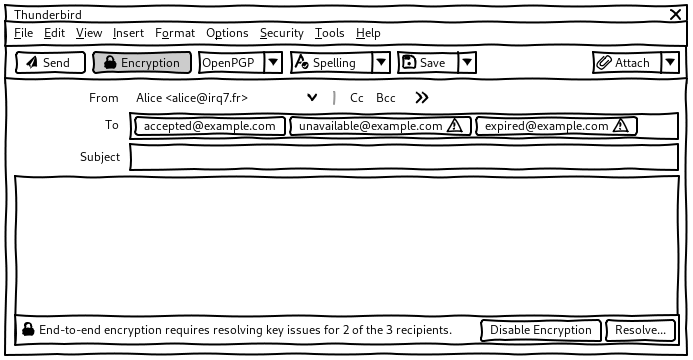
Account settings

It will replace the current radio buttons:
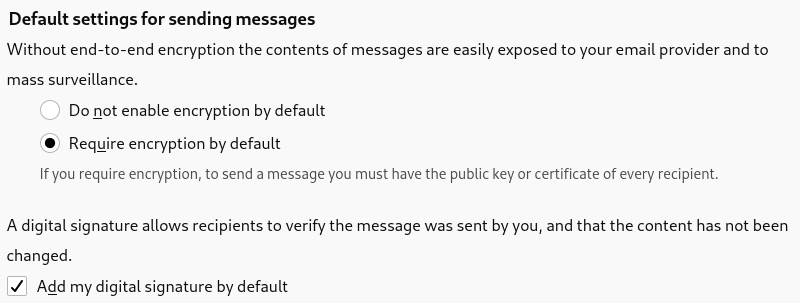
These account settings allow people to choose between 2 main categories: those who want to encrypt as little as possible and those who want to encrypt as much as possible (or everything):
-
Encrypt new messages = Off (default)
According to Ruoti et al., only 20% of non at-risk users agree with the idea that they would “encrypt email frequently.”.
Well, I’m trying to think when I would need to. It would be nice to have it, in case, but I don’t know if there’s anyone I would need to send that information to.
-
Encrypt new messages = On (default)
The at-risk users who were interviewed during the usability tests want to encrypt as much as possible, err on the side of caution, and be asked what to do with key issues as part of sensitive communications.
Sometimes you exchange keys and you think that you have it but something goes wrong. I prefer to be asked whether to send unencrypted instead of having a bad surprise. — P3
The challenge for at-risk users is to introduce enough friction in the composer to prevent them from sending sensitive communications unencrypted, while not adding too much extra burden when sending unencrypted emails.
For example, if the key of a contact expired yesterday, they want to be prevented from sending them an unencrypted email by mistake. But they don’t want to be bothered about encryption each time they write to their yoga teacher who doesn’t use OpenPGP.
Encryption toggle
Whether the user wants to encrypt the email or not is displayed in the label of the Encryption toggle button in the toolbar, right of the Send button.


Default state
When opening the composer, encryption is turned on by default depending on various heuristics:
- If the account is configured to Encrypt new messages.
- If the email is a reply to or a forward of an encrypted email.
If neither OpenPGP nor S/MIME are configured for the current identity, the toggle is off and clicking on it could open a configuration assistant (not designed yet).
Key notification
If encryption is turned on, but the user doesn’t have a valid and accepted key for one of the recipients, a key notification appears at the bottom the body of the email:

If keys are missing for several recipients:

If I’m serious about encryption, problems should be shown right away because I have to act on them anyway. The emails I work a lot with I have an interest in getting them in order. – P1
Recipient pill
When a key notification is diplayed, the pill of the problematic recipients is highlighted:

Additional options
The same OpenPGP and S/MIME options are available from either:
- The Encryption split button.
- A dedicated top-level Encryption menu.
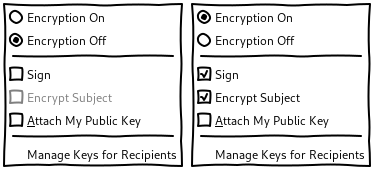
According to Kai, the options from the split button should also be available from a top-level menu for accessibility.
Moving OpenPGP and S/MIME options to a dedicated top-level menu helps to make them more discoverable. It also keeps the set of options in the split button and the top-level menu consistent and helps people understand that the top-level menu mirrors the options in the split button.
It wouldn’t be a problem to keep these options in the Options menu as we’re doing right now as most people will rather use the split button than the top-level menu.
The label of the Encryption menu is slightly incorrect technically because this menu also includes options for cryptographic signatures, and not only for encryption. Test participants didn’t care or didn’t even know about the cryptographic signature of OpenPGP. I assume that the Encryption label is clearer and most discoverable by the vast majority of users that are mostly interested in encryption. I assume that the few people who are also interested in cryptographic signatures won’t have problems finding these options in this menu despite the Encryption label.
OpenPGP-S/MIME split button
If the user has accounts with both OpenPGP and S/MIME, the choice between both encryption technologies is available from:
- A dropdown, left from the Encryption split button.
- Radio buttons, in the Encryption menu.
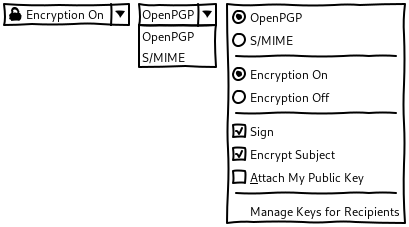
Search on key servers
Searching on key servers is made available from the recipient pills, their right-click menu, and the key notifications.
None of the test participants used key servers to share their keys: some don’t know that they exist and some others avoid using them by lack of trust.
I never search on key servers because I don’t trust them. Someone can pretend to be someone else and send a wrong key. — P2
When the user searches on key servers, it’s a good opportunity to educate them about key servers:
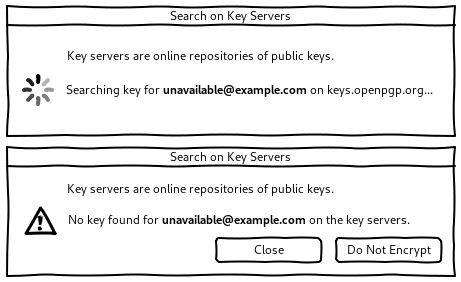
Key properties
P1 didn’t read the current text despite being interested in learning more about fingerprint verification.
I don’t know what a fingerprint is so I would choose ‘accepted’. I don’t know how I can verify if the key is correct but I’m curious what a correct fingerprint means. I want to know. I would like an explanation of the difference between ‘accepted’ and ‘verified’. — P1
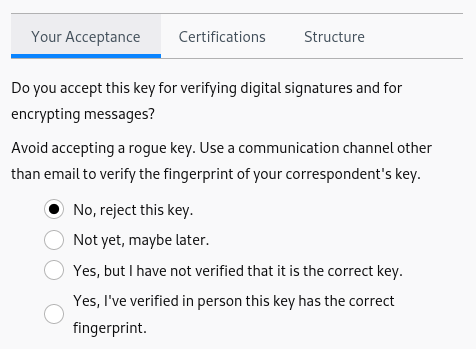
I rephrased and restructured the acceptance tab of the key properties to:
- Be less verbose on top.
- Explain better what it means to verify the fingerprint, put this explanation closer to where it matters, and separate it from the general explanation on acceptance.
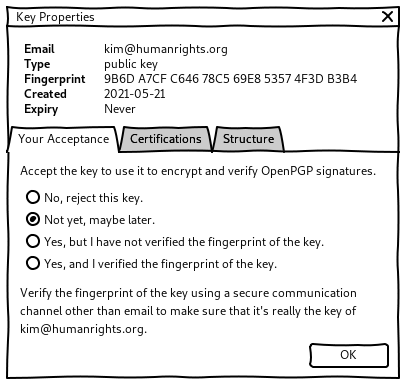
Subject encryption toggle
If encryption is turned on, subject encryption is turned on by default as well.
The status of subject encryption is displayed through a label Encrypted Subject and can be toggled with a lock icon on the left of the subject line:


-
Without the label Encrypted Subject but a padlock icon on the right of the subject line, P2 was not aware that the subject was going to be encrypted by default and typed a dummy subject instead:

I would put a subject that no one could understand, like “let’s party”. — P2
Dummy subjects like these make emails harder to go back to for the recipients.
When we made P2 notice the padlock icon while debriefing the tests by moving it to the left of the subject line, they incorrectly thought that the icon indicates that the encryption is working:

It means that encryption is working. — P2
-
With the Encypted Subject label, P3 discovered that it was now possible to encrypt the subject line as well:
“Encrypted Subject”, cool! I understand that the subject will be encrypted now. It hasn’t always been the case. — P3
Subject encryption is also available in the additional options for accessibility.
If encryption is turned off, the usual Subject line with no icon is displayed:

Implementation and release strategy
This design could be released in increments in the following order:
-
Encryption split button, additional options, and OpenPGP-S/MIME split button
Most pressing in terms of ease of use and visibility of system status.
Default state could be mapped to the current “Do Not Encrypt” and “Require Encryption”.
-
Key notifications, Never Encrypt dialog, and Send button
More useful than recipient pills.
Implementing the Never Encrypt dialog reduces the number of notifications.
-
Not super important but easy.
-
Sugar on top of key notifications.
-
Could require more discussion.
-
At-risk and less technical users are defiant of key servers and already have other key distribution mechanisms.
-
Mostly educational.
Software prototype
The following patch includes proof-of-concept code for almost all the design elements described earlier:
It can be applied on top of changeset de35d92fd3ea.
This patch is a prototype made to demonstrate the design and is probably broken in many ways. Please report any unexpected behavior.
Known issues
-
Doesn’t implement the Encrypted Subject label.
I want to see whether having the icon only works better for users on the software prototype. This label being mostly educational, it might not be a problem if people take some time to understand how subject encryption works. Going for the longer label first makes it harder to know whether the shorter label would be enough and simplify it in the future.
-
Doesn’t implement Search on key servers.
-
The Send Now entry of the File menu and the Ctrl+Enter keyboard shortcut still allow sending an email while there are pending key notifications.
-
Key notifications are not updated when coming back from the Manage Key… dialog.
-
Key notifications are placed on the bottom of the message instead of on top.
-
Doesn’t implement the link to Manage Key… and Search on Key Servers… in the tooltip of the recipient pills nor the shortcut to the key properties in the right-click menu of the recipient pill.
Next steps
-
Test the software prototype with more at-risk users.
-
Design improvements for key management and discovery.
Key assistant
Variations
Encryption split button
-
Merging the encryption toggle and additional options provides everything in the same widget under a single padlock icon. Split buttons were well understood by test participants.
-
State-switch controls are notoriously hard to get right. Reenforcing the toggle with a change in label and icon provides multiple and strong signifiers and is more accessible.
Additional features
Never Encrypt dialog
When the user chooses Do Not Encrypt in a notification:
-
The Encryption split button is turned off.
-
The user is proposed to remember this preference for this recipient in the future:
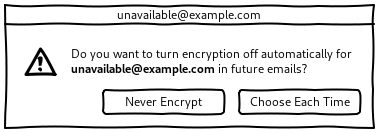
This choice is undone automatically if the user ever imports a key for this recipient in the future.